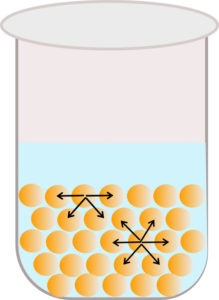Please review Intermolecular Forces for this study guide.
Viscosity
Many of the properties of liquids can be explained by interparticle or intermolecular forces. With viscosity it is intuitive that maple syrup is more viscous than water. Viscosity is the measure of a liquid’s resistance to flow. Maple syrup does not flow as easily as water making it a more viscous liquid than water. The stronger the intermolecular forces, the higher the viscosity. The weaker the intermolecular forces, the lower the viscosity. Viscosity decreases with increasing temperature. If you heat a quantity of maple syrup, it becomes less viscous. The units of viscosity are \(\mathbf{\frac{N⋅s}{m^2}}\).
Molecular shape affects viscosity. Branches and kinks in molecules will result in a higher viscosity. For example, isopropyl alcohol has a higher viscosity than 1-propanol.
Polymers have higher viscosities due to the chains of the large molecule twisting. Strong intermolecular forces of attraction limit the movement of the liquid particles since particles can not slide as easily past one another.
Surface Tension
Surface tension is the energy required to increase the surface of a liquid. The units are J/m2. The stronger the intermolecular forces of attraction, the more energy is required. Below is an image of an insect on water. The insect stays on the surface due to the high surface tension of water.
Intermolecular forces felt at the interior of a liquid are different from the intermolecular forces on the surface of a liquid. The interior molecules are equally pulled in all directions. The molecules on the surface do not feel intermolecular forces of attraction on all sides and are pulled into the liquid resulting in a net downward force. The liquid molecules adapt a shape to give the smallest surface area. The surface tension is the energy required to expand the surface area. Water has a surface tension of 7.29 x 10-2 J/m2. This means that 7.29 x 10-2 J of energy is required to increase the surface area of a given amount of water by 1 m2. Water has a high surface tension due to intermolecular hydrogen bonding.
Surface tension increases with stronger intermolecular forces and decreases with increasing temperature. See the table below for surface tensions and viscosities of some common substances.
Capillarity
Capillarity is when a liquid rises up a small thin opening (a tube) against the gravitational pull. If a straw is in a glass of water, or another drink, the liquid in the straw will be higher than the liquid in the glass. You have most likely used capillary tubes in the lab to check melting points. Again, the liquid is pulled up into the tube. There are two opposing forces at work here. Cohesive forces are the attractive forces between particles or molecules of the same substance. Adhesive forces are the attractive forces between molecules of different substances. In the figure below, we see water has a concave meniscus. This is due to the strong adhesive forces between water and glass. Glass is SiO2 and the water molecules form hydrogen bonds with the oxygen in the SiO2. The adhesive forces are stronger than the cohesive forces.
Mercury has a convex meniscus because mercury atoms are not attracted to glass. The cohesive forces are much greater than the adhesive forces.
Worksheet: Properties of Liquids
Exercises
Exercise 1. Ethanol, C2H5OH, and dimethyl ether, CH3–O–CH3, are constitutional isomers. Which would have the higher surface tension. Explain why.
Check Solution/Answer to Exercise 1
Exercise 2. Which substance in each pair has the highest viscosity?
Check Solution/Answer to Exercise 2
Exercise 3. Which would have the highest viscosity, water or dimethyl sulfide, (CH3)2S. Explain.
Check Solution/Answer to Exercise 3
Exercise 4. Water flows quickly through the narrow opening of a bottle while molasses flows slowly. Is this due to the differences in viscosity or in surface tension?
Check Solution/Answer to Exercise 4
Exercise 5. Explain the differences in viscosity, surface tension, and capillarity.
Check Solution/Answer to Exercise 5
Back to Liquids
Back to Study Guides for General Chemistry 2


